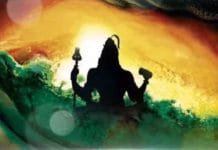INVC News
Kashi : Explore the enigmatic bond between Lord Shiva and the moon god through ancient legends. Discover how their connection symbolizes cosmic balance and devotion in Hindu mythology.
Mahadev stands supreme, revered not only for his immense power but also for his swift responsiveness to the devotion of his followers. Bholenath, as Lord Shiva is endearingly called, possesses the remarkable ability to swiftly dispel the troubles that plague mortals. He stands as a deity who readily bestows his benevolence upon those who seek it.

Upon hearing the name Mahadev, a distinctive image takes form within the minds of all. A necklace of serpents adorning his neck, a trident clutched firmly in hand, and his long, untamed hair cascading down—all these details come to the forefront. Yet, there’s an additional captivating aspect: the moon itself graces Lord Shiva Shankar’s crown. This prompts a question that has undoubtedly arisen in many minds: why does the moon, a representation of the moon god, perch upon Lord Shiva’s head? The answer to this query can be found within the profound verses of the Shiva Purana, revealing a tale that we shall delve into comprehensively.

The Mythological Underpinning
The Shiva Purana elucidates a captivating narrative regarding the moon’s unique position atop Lord Shiva’s head. It is recounted that during the celestial event of the ocean’s churning, an ominous poison emerged, casting distress among gods and demons alike. The potency of this poison engendered a collective sense of bewilderment, compelling each entity to contemplate a remedy. In this dire circumstance, Lord Shiva stepped forth and consumed the toxic substance, safeguarding the very fabric of the universe. The aftermath saw the poison accumulating within his throat, leading to his epithet ‘Neelkanth’—the blue-throated one. As the poison’s influence instigated a surge in his body’s temperature, distress permeated the divine realm.
Fueled by concern for Bholenath’s well-being, the pantheon of gods and goddesses endeavored to devise a solution that could alleviate the fiery torment within him. Their supplications were directed toward the moon god, beseeching him to rest upon Lord Shiva’s head. The intent behind this appeal was to harness the moon’s innate coolness, tempering the scorching effects of the poison. Thus, Lord Shiva came to adorn the moon on his head, a visual emblem of this sacred symbiosis.
An Alternative Narrative
In the rich tapestry of myths, another thread weaves a different explanation for the moon’s position upon Shiva’s head. This account revolves around King Daksha, who presided over twenty-seven daughters, each of whom he united with the moon in matrimony. However, this union was governed by a stipulation: the moon must treat all twenty-seven wives with parity. Amongst these unions, the moon formed a particularly profound bond with Rohini, igniting feelings of neglect and discontent among the other princesses. Their grievances were voiced to their father, King Daksha, prompting his ire. In response, he placed a curse upon the moon, afflicting it with a grievous ailment—tuberculosis. The consequences extended beyond physical affliction, manifesting as the moon’s varying phases.
In this somber juncture, Narad Muni, the celestial sage, intervened and advised the moon to seek solace through the veneration of Bholenath. The moon heeded this counsel and embarked on a devoted spiritual journey, thereby securing Lord Shiva’s favor. The deity’s grace facilitated the moon’s recovery from its ailment, culminating in its full and unblemished radiance on the night of the full moon. In an act of profound reverence, the moon entreated Lord Shiva to assume its position atop his head—a request that was granted, cementing the enduring connection between the two celestial entities.
In Conclusion
The celestial tale of the moon gracing Lord Shiva’s head carries profound symbolism, intricately woven through the fabric of mythology. Whether as a response to the critical need to temper poison’s wrath or a result of the moon’s humble submission to divine grace, the moon’s presence atop Lord Shiva’s crown epitomizes the harmonious interplay of cosmic forces. This visual spectacle, rooted in ancient lore, continues to capture the imagination of those who seek to unravel the enigmatic layers of Hindu mythology.














